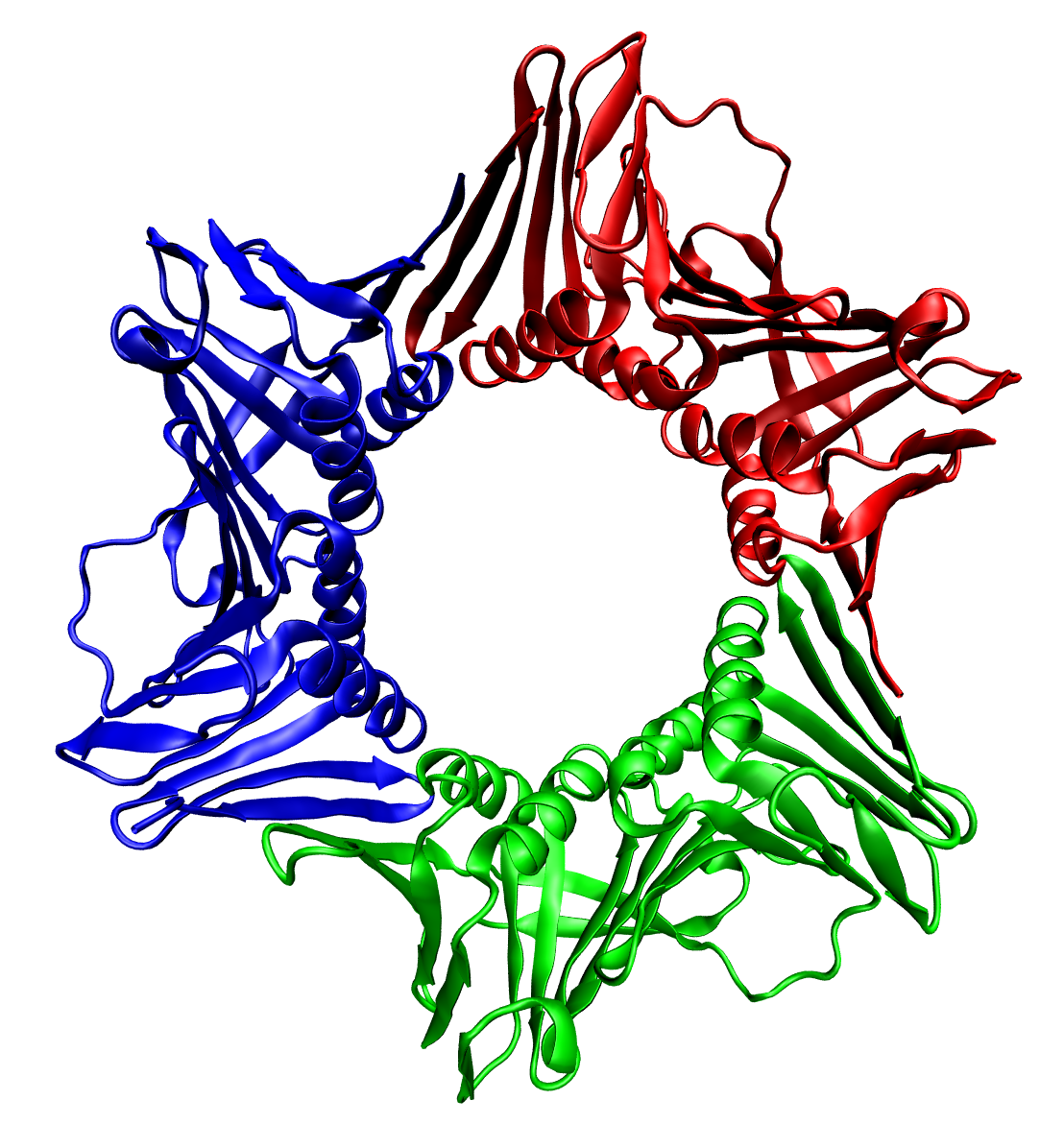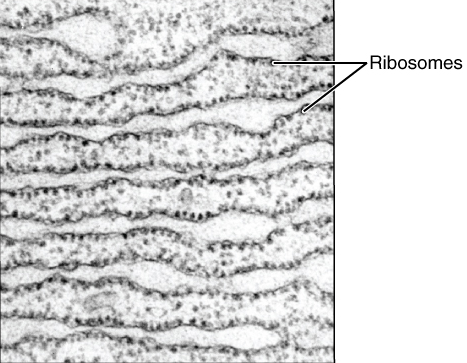|
Bacterial Microcompartment
Bacterial microcompartments (BMCs) are organelle-like structures found in bacteria. They consist of a protein shell that encloses enzymes and other proteins. BMCs are typically about 40–200 nanometers in diameter and are made entirely of proteins. The shell functions like a membrane, as it is selectively permeable. Other protein-based compartments found in bacteria and archaea include encapsulin nanocompartments and gas vesicles. Discovery The first BMCs were observed in the 1950s in electron micrographs of cyanobacteria, and were later named carboxysomes after their role in carbon fixation was established. Until the 1990s, carboxysomes were thought to be an oddity confined to certain autotrophic bacteria. But then genes coding for proteins homologous to those of the carboxysome shell were identified in the ''pdu'' (propanediol utilization) and ''eut'' (ethanolamine utilization) operons. Subsequently, transmission electron micrographs of ''Salmonella'' cells grown on propanedi ... [...More Info...] [...Related Items...] OR: [Wikipedia] [Google] [Baidu] |
Carboxysome And Bacterial Microcompartments
Carboxysomes are bacterial microcompartments (BMCs) consisting of polyhedral protein shells filled with the enzymes ribulose-1,5-bisphosphate carboxylase/oxygenase (RuBisCO)—the predominant enzyme in carbon fixation and the rate limiting enzyme in the Calvin cycle—and carbonic anhydrase. Carboxysomes are thought to have evolved as a consequence of the increase in oxygen concentration in the ancient atmosphere; this is because oxygen is a competing substrate to carbon dioxide in the RuBisCO reaction. To overcome the inefficiency of RuBisCO, carboxysomes concentrate carbon dioxide inside the shell by means of co-localized carbonic anhydrase activity, which produces carbon dioxide from the bicarbonate that diffuses into the carboxysome. The resulting concentration of carbon dioxide near RuBisCO decreases the proportion of ribulose-1,5-bisphosphate oxygenation and thereby avoids costly photorespiratory reactions. The surrounding shell provides a barrier to carbon dioxide ... [...More Info...] [...Related Items...] OR: [Wikipedia] [Google] [Baidu] |
Hexameric Protein
Protein quaternary structure is the fourth (and highest) classification level of protein structure. Protein quaternary structure refers to the structure of proteins which are themselves composed of two or more smaller protein chains (also referred to as subunits). Protein quaternary structure describes the number and arrangement of multiple folded protein subunits in a multi-subunit complex. It includes organizations from simple dimers to large homooligomers and complexes with defined or variable numbers of subunits. In contrast to the first three levels of protein structure, not all proteins will have a quaternary structure since some proteins function as single units. Protein quaternary structure can also refer to biomolecular complexes of proteins with nucleic acids and other cofactors. Description and examples Many proteins are actually assemblies of multiple polypeptide chains. The quaternary structure refers to the number and arrangement of the protein subunits wit ... [...More Info...] [...Related Items...] OR: [Wikipedia] [Google] [Baidu] |
Applied And Environmental Microbiology
''Applied and Environmental Microbiology'' is a biweekly peer-reviewed scientific journal published by the American Society for Microbiology. It was established in 1953 as ''Applied Microbiology'' and obtained its current name in 1975. Articles older than six months are available free of cost from the website, however, the newly published articles within six months are available to subscribers only. According to the '' Journal Citation Reports'', the journal has a 2021 impact factor of 5.005. The journal has been ranked as one of the top 100 journals over the past 100 years in the fields of biology and medicine. Special Libraries Association100 Journals in last 100 years/ref> The editor-in-chief An editor-in-chief (EIC), also known as lead editor or chief editor, is a publication's editorial leader who has final responsibility for its operations and policies. The highest-ranking editor of a publication may also be titled editor, managing ... is Gemma Reguera ( Michigan State U ... [...More Info...] [...Related Items...] OR: [Wikipedia] [Google] [Baidu] |
Journal Of Experimental Botany
The ''Journal of Experimental Botany'' (''JXB'') is a peer-reviewed scientific journal published by Oxford University Press on behalf of the Society for Experimental Biology. It covers research on plant biology, focusing on molecular physiology, molecular genetics, and environmental physiology. Some of its content is available under an open access licence. The editor-in-chief is John Lunn ( Max Planck Institute of Molecular Plant Physiology). Research is published in five key areas: growth and development, cell biology, metabolism, plant-environment interactions, and crop molecular genetics. References External links * Submission websiteSociety for Experimental Biology websiteJournal of Experimental Botanyat SCImago Journal Rank Journal of Experimental Botanyat HathiTrust HathiTrust Digital Library is a large-scale collaborative repository of digital content from research libraries including content digitized via Google Books and the Internet Archive digitization initiati ... [...More Info...] [...Related Items...] OR: [Wikipedia] [Google] [Baidu] |
Murray R
Murray may refer to: Businesses * Murray (bicycle company), an American manufacturer of low-cost bicycles * Murrays, an Australian bus company * Murray International Trust, a Scottish investment trust * D. & W. Murray Limited, an Australian wholesale drapery business * John Murray (publishing house), a British publishing house Fictional characters *Murray Monster, a muppet in ''Sesame Street'' *Little Murray Sparkles, a cat in ''Sesame Street'' * Murray (''Monkey Island''), a character in the video game series * Murray (''Sly Cooper''), a character in the video game series *Murray Slaughter, a regular character in ''The Mary Tyler Moore Show'' *Murray, the mascot of the band Dio *Murray, in the 2015 Netflix series '' Richie Rich'' *Murray, a ''Hotel Transylvania'' character *Murray the Cop, in ''Fat Pizza'' *Murray Smith, in ''Swift and Shift Couriers'' People *Murray (surname) *Murray (given name) Places Australia * Division of Murray, federal electoral district in Victori ... [...More Info...] [...Related Items...] OR: [Wikipedia] [Google] [Baidu] |
Journal Of Bacteriology
The ''Journal of Bacteriology'' is a biweekly peer-reviewed scientific journal established in 1916. It is published by the American Society for Microbiology and the editor in chief is George A. O'Toole (Dartmouth College). The journal is delayed open access: content is available for free at the journal's website and at PubMed Central after a six-month embargo. The journal is also hybrid open access allowing authors to pay an article processing fee for their articles to be available for free immediately. Abstracting and indexing The journal is abstracted and indexed in: According to the ''Journal Citation Reports'', the journal has a 2020 impact factor The impact factor (IF) or journal impact factor (JIF) of an academic journal is a scientometric index calculated by Clarivate that reflects the yearly mean number of citations of articles published in the last two years in a given journal, as ... of 3.490. References External links *{{Official website, http://jb.asm.org/ ... [...More Info...] [...Related Items...] OR: [Wikipedia] [Google] [Baidu] |
Encapsulin
The encapsulins are a family of bacterial proteins that serve as the main structural components of encapsulin nanocompartments. There are several different encapsulin proteins, including EncA, which forms the shell, and EncB, EncC, and EncD, which form the core. References {{reflist Cell biology Metabolism Biological engineering Bacterial proteins ... [...More Info...] [...Related Items...] OR: [Wikipedia] [Google] [Baidu] |
Substrate Channeling
Substrate channeling is the passing of the intermediary metabolic product of one enzyme directly to another enzyme or active site without its release into solution. When several consecutive enzymes of a metabolic pathway channel substrates between themselves, this is called a metabolon. Channeling can make a metabolic pathway more rapid and efficient than it would be if the enzymes were randomly distributed in the cytosol, or prevent the release of unstable intermediates. It can also protect an intermediate from being consumed by competing reactions catalyzed by other enzymes. Channeling can occur in several ways. One possibility, which occurs in the pyruvate dehydrogenase complex, is by a substrate being attached to a flexible arm that moves between several active sites (not very likely). Another possibility is by two active sites being connected by a tunnel through the protein and the substrate moving through the tunnel; this is seen in tryptophan synthase. A third possibility i ... [...More Info...] [...Related Items...] OR: [Wikipedia] [Google] [Baidu] |
Metabolic Pathway
In biochemistry, a metabolic pathway is a linked series of chemical reactions occurring within a cell. The reactants, products, and intermediates of an enzymatic reaction are known as metabolites, which are modified by a sequence of chemical reactions catalyzed by enzymes. In most cases of a metabolic pathway, the product of one enzyme acts as the substrate for the next. However, side products are considered waste and removed from the cell. These enzymes often require dietary minerals, vitamins, and other cofactors to function. Different metabolic pathways function based on the position within a eukaryotic cell and the significance of the pathway in the given compartment of the cell. For instance, the, electron transport chain, and oxidative phosphorylation all take place in the mitochondrial membrane. In contrast, glycolysis, pentose phosphate pathway, and fatty acid biosynthesis all occur in the cytosol of a cell. There are two types of metabolic pathways that are cha ... [...More Info...] [...Related Items...] OR: [Wikipedia] [Google] [Baidu] |
Endomembrane System
The endomembrane system is composed of the different membranes (endomembranes) that are suspended in the cytoplasm within a eukaryotic cell. These membranes divide the cell into functional and structural compartments, or organelles. In eukaryotes the organelles of the endomembrane system include: the nuclear membrane, the endoplasmic reticulum, the Golgi apparatus, lysosomes, vesicles, endosomes, and plasma (cell) membrane among others. The system is defined more accurately as the set of membranes that forms a single functional and developmental unit, either being connected directly, or exchanging material through vesicle transport. Importantly, the endomembrane system does not include the membranes of plastids or mitochondria, but might have evolved partially from the actions of the latter (see below). The nuclear membrane contains a lipid bilayer that encompasses the contents of the nucleus. The endoplasmic reticulum (ER) is a synthesis and transport organelle that br ... [...More Info...] [...Related Items...] OR: [Wikipedia] [Google] [Baidu] |
Synechococcus Elongatus PCC 7942 Electron Micrograph Showing Carboxysomes
''Synechococcus'' (from the Greek ''synechos'', in succession, and the Greek ''kokkos'', granule) is a unicellular cyanobacterium that is very widespread in the marine environment. Its size varies from 0.8 to 1.5 µm. The photosynthetic coccoid cells are preferentially found in well–lit surface waters where it can be very abundant (generally 1,000 to 200,000 cells per ml). Many freshwater species of ''Synechococcus'' have also been described. The genome of ''S. elongatus'' strain PCC7002 has a size of 3,008,047 bp, whereas the oceanic strain WH8102 has a genome of size 2.4 Mbp. Introduction ''Synechococcus'' is one of the most important components of the prokaryotic autotrophic picoplankton in the temperate to tropical oceans. The genus was first described in 1979, and was originally defined to include "small unicellular cyanobacteria with ovoid to cylindrical cells that reproduce by binary traverse fission in a single plane and lack sheaths". This definition of ... [...More Info...] [...Related Items...] OR: [Wikipedia] [Google] [Baidu] |





